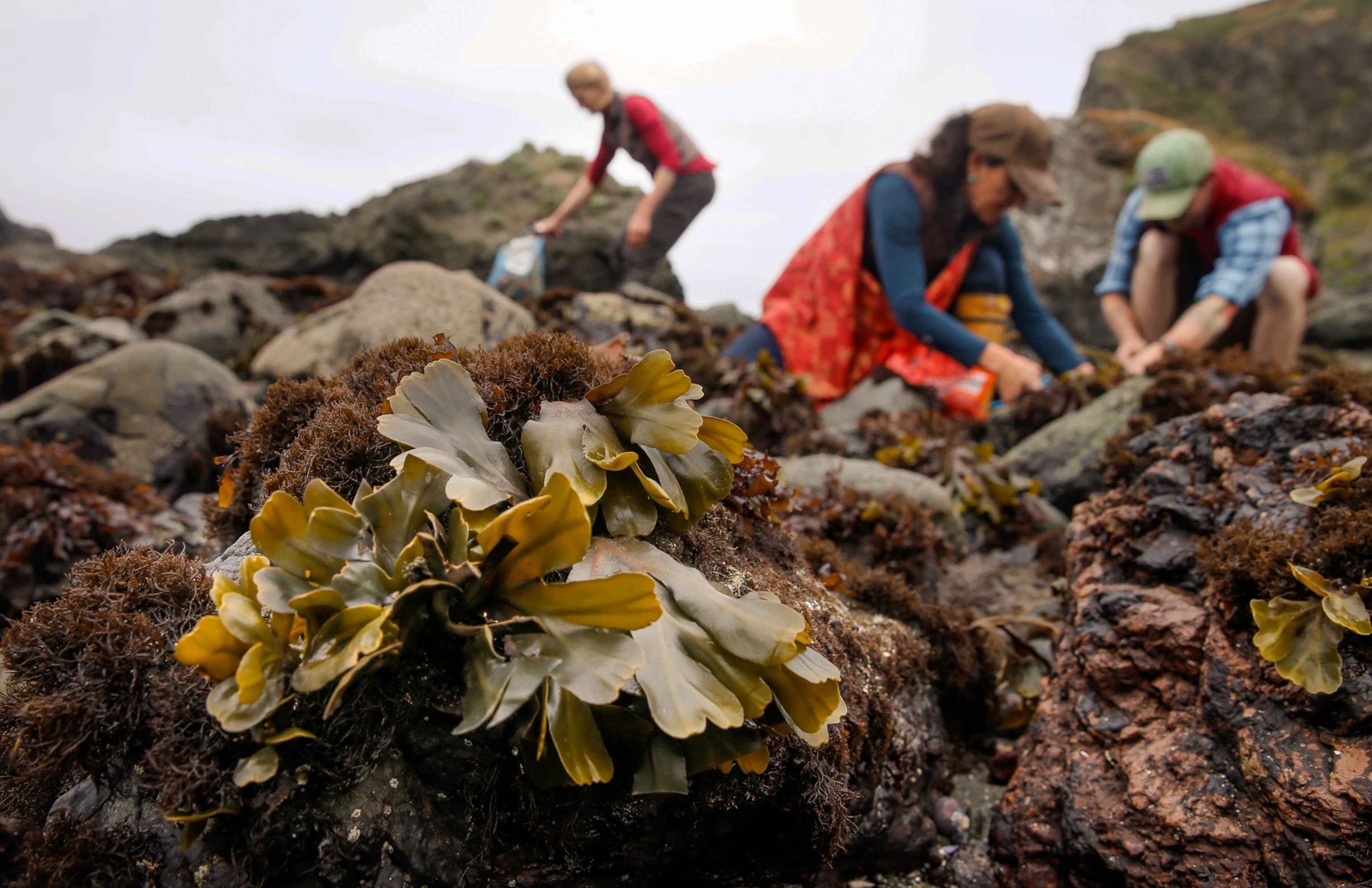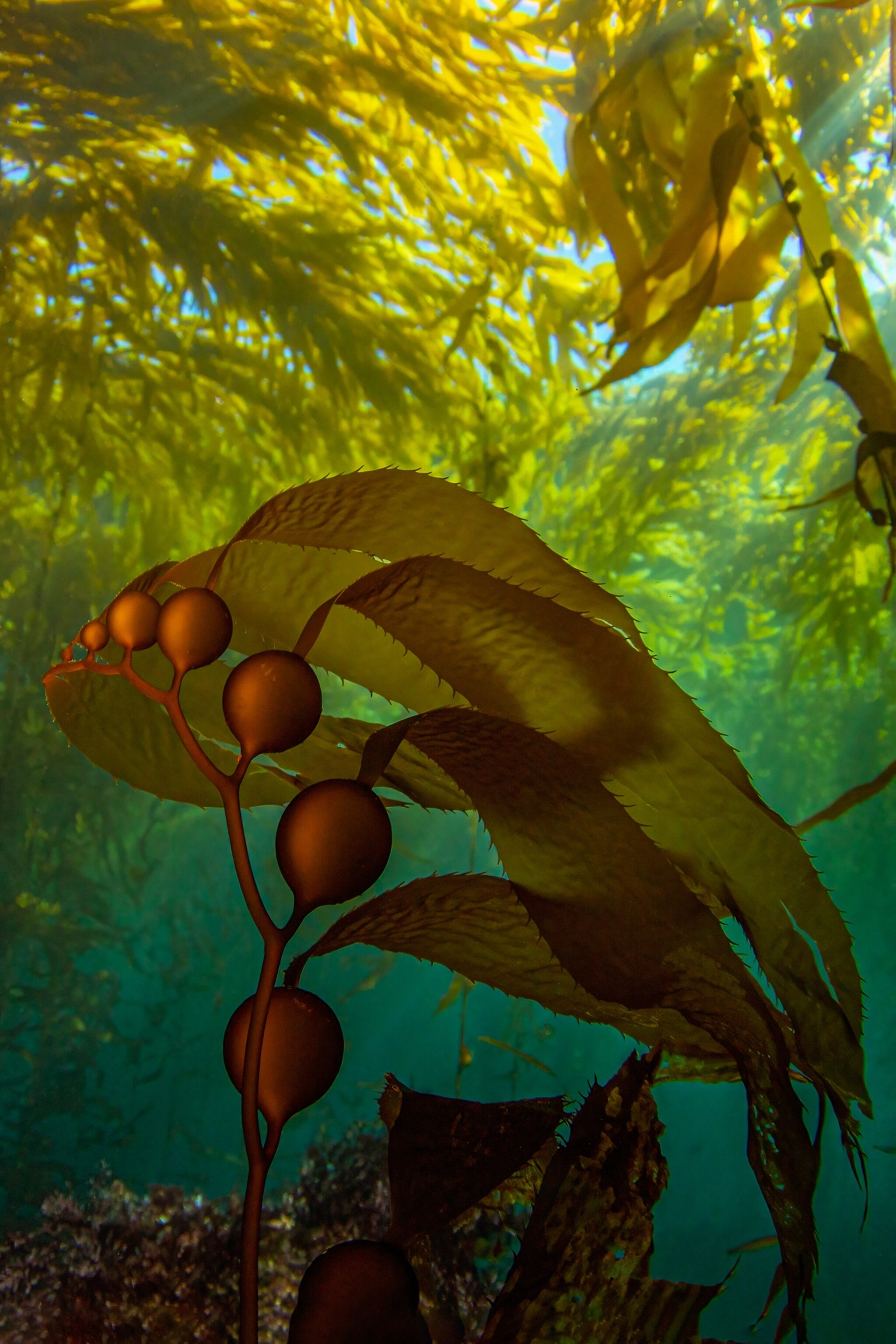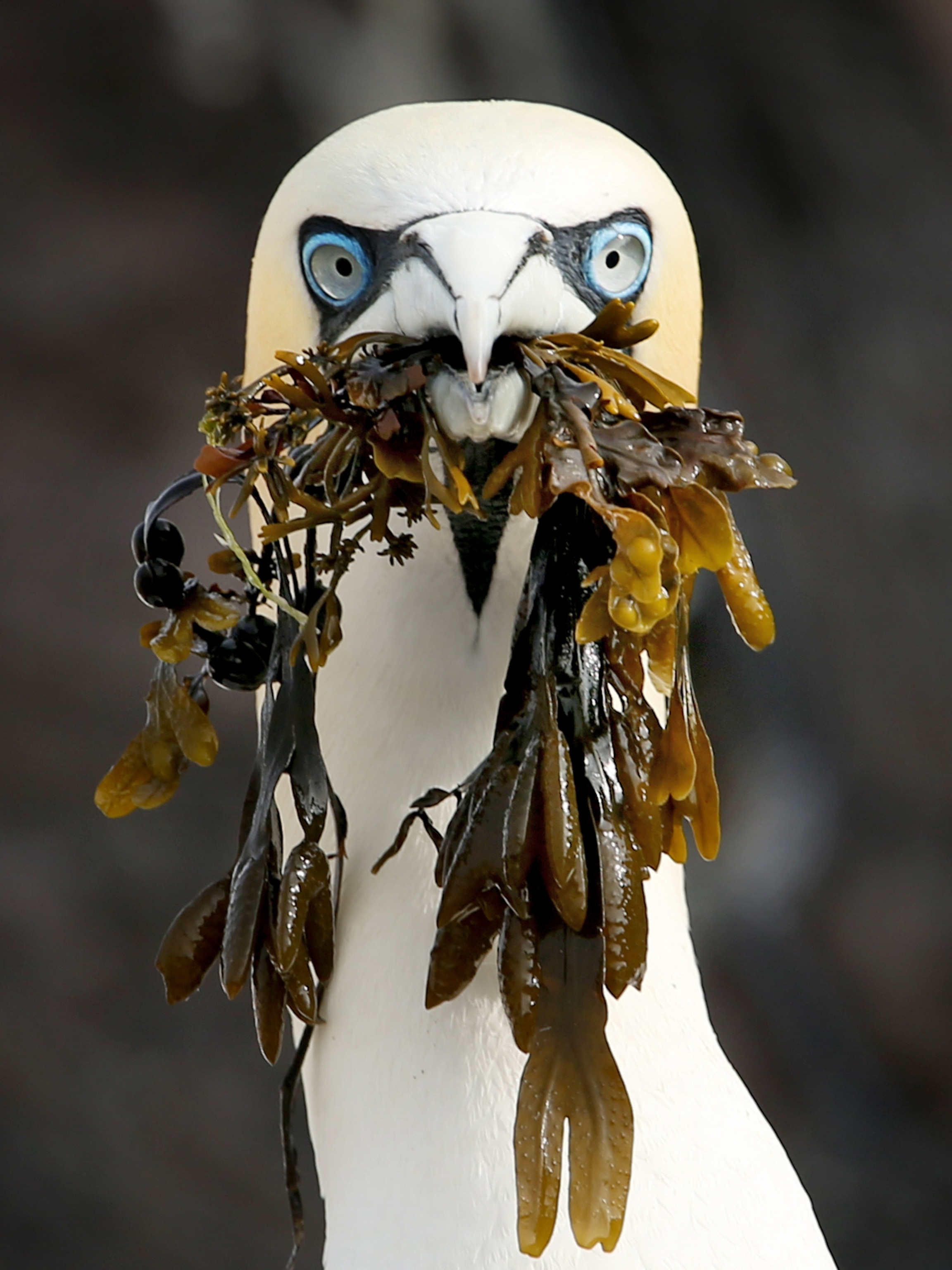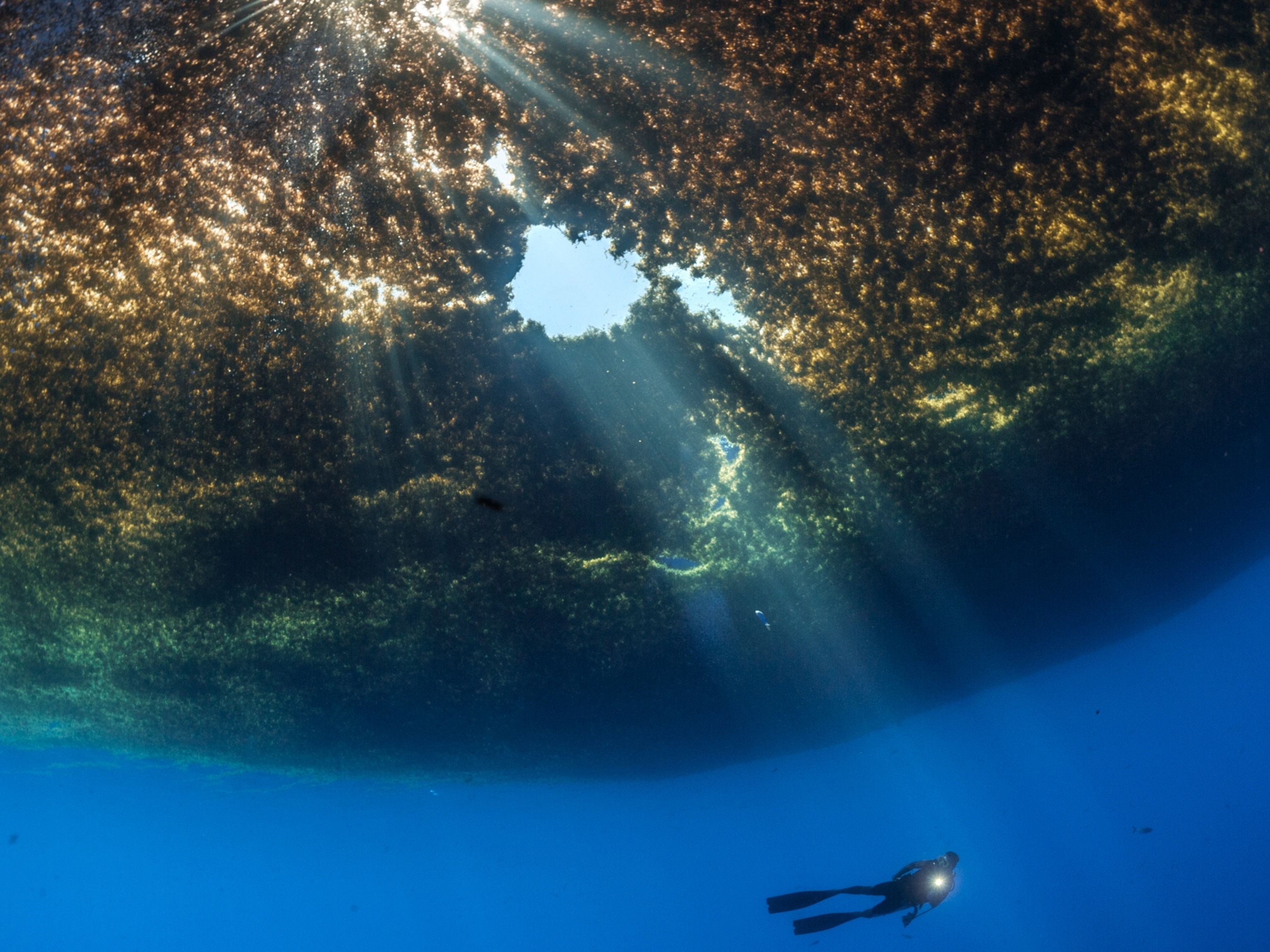
Seaweed is a superfood you can forage. Here’s how.
The newest seaside trend is searching for seaweed—a fun and sustainable way to explore the world’s coastal areas.
The foragers strap on their helmets and head down to the intertidal zone in East Neuk along the coast of Fife, Scotland. At the water’s edge, their guide, Jayson Byles, owner of East Neuk Seaweed Foraging, points out a variety of seaweed growing on the rocks and floating in the pools: long, olive-colored strands of sea spaghetti and ruffles of grass-green sea lettuce—perfect for an afternoon feast.

A couple hours later, the foragers carry their bounty back to the beach, where Byles builds a fire and whips up a sauce for the sea spaghetti, whose mild flavor can take a vegan pesto, carbonara, or mushroom bacon cream sauce, depending on his guests’ preferences. The sea lettuce, with its slightly salty marine flavor, is wrapped around fresh fish and panfried. Each seaweed has a different flavor profile, Byles explains. One type of red seaweed, called dulse, can even taste like bacon, in certain preparations.
As a lifelong forager, Byles is passionate about introducing people to this kind of sustainable eating. The best part, he says, is sharing the experience. “It’s a really nice way to get a sort of community happening where we’re sharing food that we’ve gathered,” he says. “There’s something very ancient about that.”

Around the world, people have long foraged for seaweed. In recent years, the activity has surged in popularity as more people discover the health benefits of this superfood. Flavoring soups, tossed with a dressing, or dried into sheets, it’s a staple in many Asian countries, including Japan, where the prefecture of Okinawa is a designated “blue zone” of longevity. What’s more, the experience of harvesting in nature can forge deep conservation connections with coastal areas, especially when the result is a tasty meal.
While many varieties of seaweed are edible, there are best practices to keep in mind while foraging by the sea. Besides taking safety precautions among the slippery rocks, especially near powerful and unpredictable ocean waves, Byles emphasizes the importance of being light on the land, harvesting only a small part of each plant, and always cutting above the holdfast—never pulling seaweed off the rocks. Here’s what else to know about foraging for seaweed.
Seaweed foraging basics
A lot goes into a safe and rewarding foraging trip, and an experienced and knowledgeable guide can make a big difference. They can educate people on factors big and small, from how the local coastal ecosystem works to what to wear for maximum safety while poking around slippery rocks.
Being able to decipher weather and tidal forecasts and knowing when the sun goes down for maximum visibility are essential. Any number of factors, like high surf advisories, poor weather, water quality, and recent rainfall—leading to runoff—can cancel or delay a trip. Guides also provide information about local rules and regulations—which can vary widely—as well as teach participants how to harvest, clean, and prepare seaweed responsibly.

(How urban foraging became the new way to explore a city.)
Harvesting seaweed responsibly is key to Melissa Hanson, co-founder of Kelpful, which leads foraging adventures for adults and kids near San Luis Obispo, California. “We talk about [how] this beautiful, fragile, wild space is not a grocery store. You can’t just walk into it and take what you want,” she says. “We talk about having a relationship of reciprocity and having a lot of gratitude and respect for the abundance that is there and recognizing that it doesn’t just exist for us to take for our own uses.”
Part of that ethos is being mindful when collecting, Hanson explains. “We only harvest [seaweed] varieties that are in great abundance at that time and in that place, and we take a very small amount compared to the total that is there,” she says. “Our goal, when we’re done, is for [the area] to not look like we were there at all.”
Cultural connections
Foraging for seaweed is an important cultural practice in many communities around the world. In Wales, foragers collect seaweed to make laverbread, a centuries-old tradition. Along the coast of Tasmania, Australia, (known as lutruwita to the palawa, Tasmanian Aboriginal people, the original inhabitants of the island), the wukalina Walk takes visitors on a four-day, three-night journey involving hiking, cultural experiences, and traditional foods, like seaweed and shellfish.


(See America’s parks with Indigenous peoples who first called them home.)
Along the trip, palawa guides (whose language does not capitalize many words and place names) teach how to shape and dry kelp into a bowl inspired by traditional water carrying vessels. They forage for seaweed and enjoy sea asparagus, sea lettuce, and many other delicacies.
Melissa West, operations manager for wukalina Walk, explains that palawa women traditionally dive to collect seaweed, food, and shells from endemic kelp-dwelling mollusks called maireeners, which they then transform into jewelry. “I’ve got two daughters, so it’s really important for me to pass that knowledge down to them,” West adds.


Byles, too, believes it is crucial to pass along his foraging knowledge, much of which comes from his Maori ancestry. Doing so, he believes, is especially beneficial for young people, to instill a sense of environmental responsibility. “I like working with the kids because it’s important the next generations get to know these areas and get to fall in love with the beach and coast,” he says.
Delicious dishes
When it comes to eating seaweed, one key aspect may be its versatility, which can help with even the pickiest eaters—children. Vincent Nattress, a chef, serves commercially harvested seaweed at Orchard Kitchen, the Langley, Washington-based restaurant he co-owns with his wife, Tyla.
(This seaweed is good for you—and for the environment.)
Nattress may make some types of seaweed into a seasoning blend, similar to Japanese furikake. Other types may be served as pickles or blended into a sauce. “It’s got this amazing ability to add the same kind of umami [flavor] characteristic you might get from mushrooms,” Nattress says.
At home, he prepares wild seaweed, gathered with a shellfish/seaweed fishing license, that his teenagers are happy to eat. Now, he says, they are always up for a culinary adventure even while traveling. “There’s nothing they won’t eat because they’ve been exposed to everything.”
No matter how you prepare seaweed, it all comes down to the experience. “Getting folk reconnected to our roots and into nature, for me, that’s a massive part of foraging,” says Byles. “It’s not just about seaweed. It’s about the environment, it’s about reconnecting to the land, and the waters, and each other as well.”
You May Also Like






